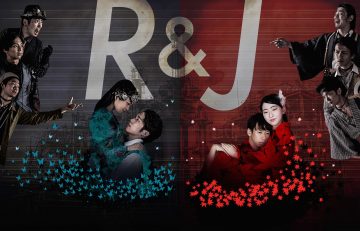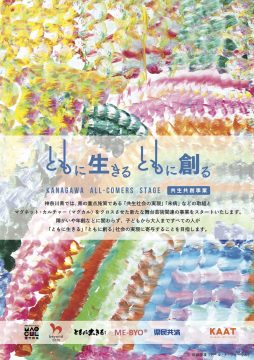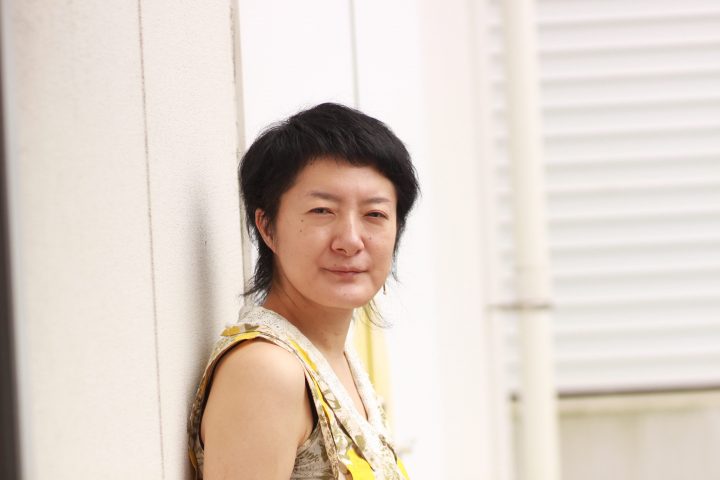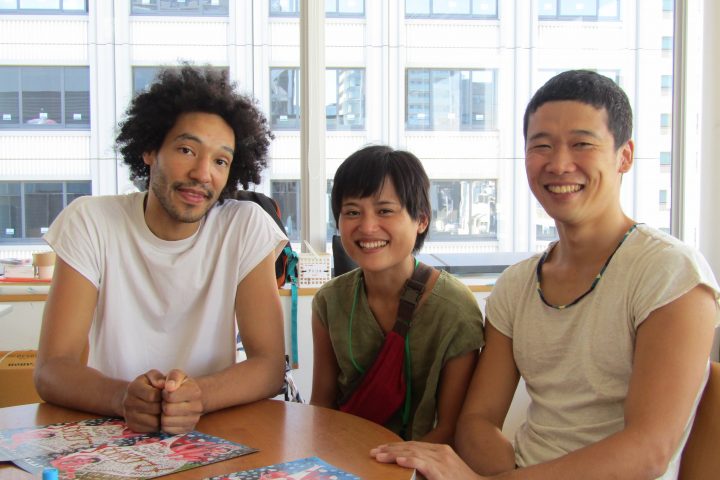Momoko Shirakami x Yukina Sakai "A dance full of surprises and betrayals undertaken by two people who at first glance seem to be opposites but have something in common"

Profile
Shiraga Momoko
http://www.momongacomplex.info/
He founded and led Momonga Complex in 2005. He is well known for his choreography and direction that proactively incorporates meaninglessness and waste to create unique spaces, and from April 2008 to March 2011, he performed mainly at the Fujimi Civic Cultural Center Kirari Fujimi in Saitama Prefecture as part of the Kiralink Company. He has also presented many small works at events such as the Yokohama Triennale 2008 and the Echigo-Tsumari Art Triennale 2009. He was a supporting artist for Steep Slope Studio in 2013.
Sakai Yukina
http://www.sakaiyukina.net/
She is well known for her supple and delicate expressions, and has performed in a variety of productions. She has been consistently presenting her own works since 2007, composing and directing unique spaces. She also works across the fields of music, architecture, and art, and is involved in a wide range of activities, including choreography and appearances in theater productions, music videos, and advertisements. She received the Future Award at the 60th Kanagawa Culture Award. She was a supporting artist for Steep Slope Studio in 2013.
A mysterious world woven by eccentric, lovable people in situations that are a little out of the ordinary. Momoko Shirakami, the founder of Momonga Complex, weaves humor and pathos into her stage performances, which are full of fun and deep observations of humanity. Meanwhile, Yukina Sakai presents solo and group works that reflect her sensitive sensibility. She actively collaborates with musicians and artists, and has choreographed and appeared in many music videos. She is attracting attention as a talented and versatile dancer and choreographer. The two are support artists of Steep Slope Studio in Oimatsucho, Nishi-ku, Yokohama, and often perform in Yokohama. We spoke to them ahead of the performance of Stick & uS!! ~Us and the Stick~, in which they choreograph each other's solo works.
Interview & Text by Morihiko Takahashi (dance critic) / Photography by Masanobu Nishino
Cooperation: Steep Slope Studio/Nogeyama Zoo
- How the two met -
-Please tell us your impressions of each other.
Shirakami : I had seen Sakai-san's work before. I thought she was cute (laughs). If my work is on the clumsy side, then I thought she was smart. I admired her. We had chances to see each other's work and we performed together in the same space, but we never had any interaction. Last year, I saw her ensemble work for the first time. The first half went as I had imagined (for Sakai-san), but the second half had a scene that was like a festival. There was a moment when she suddenly resonated with me, and I thought, "I might like her" and "I could talk to her!"
Sakai : It was for "We Are Alive, Dust" which was performed at Noge (Noge) Schale in June 2012. I used the fourth movement of Beethoven's Symphony No. 5, and scattered dust and made a mess with a vacuum cleaner.
Shiragami : I felt like we had things in common, like we could talk, and there were things I liked when I watched his movements. But I don't think I could make things like that myself.
Sakai : Shirakami-san creates warm and friendly works. He has a relaxed personality and a wandering image. He has a relaxed feel to him.
Shirakami : I thought Sakai-san was very stylish.
Sakai : I'm quite clumsy. I'm clumsy (laughs).
Shirakami : That's what I thought when we started practicing together (laughs). I was like, Wow!
Sakai : Shirakami-san creates pieces with an atmosphere that I cannot create. He has a strong foundation and his dance choreography is solid.
The catchphrase for Momonga Complex is "dance performance-like," but I think the person behind it is someone who is good at creating meticulous choreography.

"We Are Alive, Dust" @ Noge Shale 2012
Photo: Ryuichiro SUZUKI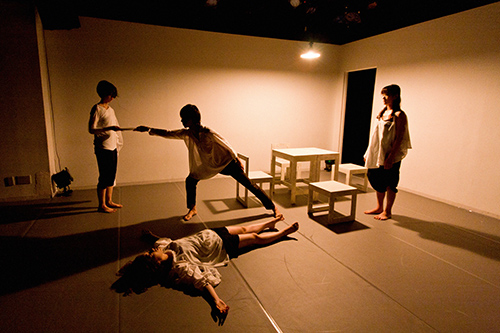
"Night in June" @ST Spot 2010 Photo: Kenki IIDA
- Interests and motivations in creativity -
-What do you usually keep in mind when choreographing?
Sakai : Even though I call it choreography, I have no interest or obsession with creating movement forms. Rather than being interested in the body itself, I create stage works that are conscious of the space in which they are performed, and works that are conscious of space. I create with an interest in how people appear and how bodies and objects are arranged in space. I am interested in the moment when a story or emotion emerges from that. It's more like creating a landscape painting from a distance, rather than converting the movement of the body or inner energy into choreography.
My own aesthetic is how to arrange the body, light, and sound to blend in with the atmosphere of the space and bring out its potential. Rather than conveying a big message, I create beautiful images, hoping to have a moment that resonates with the viewer.
Rather than being motivated by an interest in the body itself, I create stage works that are conscious of the space in which they are performed, and works that are conscious of space. I create with an interest in how people appear and how bodies and objects are positioned in a space.
--It's true that even though it's called choreography, there are aspects that go beyond just "creating choreography."
Sakai : To me, arranging people, or even just arranging cups even if there are no people, is choreography and dance. I don't think many people say this, but...
-What about you, Shiragami-san?
Shirakami : I can't dance... Well, I don't dance, or rather, I can dance when music starts, but I'm not the type of person who can start dancing when someone says, "Dance!" Even if someone says, "You're a dancer, right? Dance!", I'm like, "No, I don't dance..." (laughs). That's why I'm particular about the motivation or trigger to start dancing. Sometimes I suddenly make someone dance as part of a production, but even in those cases, I create something like a prelude. I have something in mind that will make me start dancing.
Also, I try to make people vulnerable by removing any armor. I want to be completely naked. I want to be in a state where there is nothing to protect me. I'm particular about how I dance from that moment onwards, when I go on stage but I'm not wearing any armor, or when I come out looking all cool but then realize I'm not wearing any pants.
Sakai : At first glance he seems clumsy, but he's so earnest it's shocking.
Shirakami : It's like I'm willingly going to become an arrow duck (laughs). Like I'm going to die.
Sakai : I want to be an arrowhead too!
Shirakami : (Rehearsals begin) It's already piercing me (laughs).
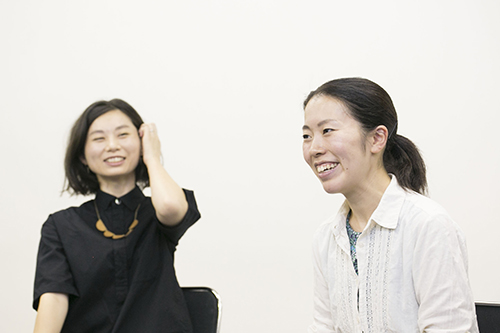
- Choreographing and being choreographed -
-This time you will be choreographing each other's solos, but are there any differences between you as a choreographer and as a dancer?
Shirakami : The desires of a dancer and the desires of a director are completely different. I'm performing in my own works, but if I were an outside dancer I might not want to perform in them... that's the dilemma I'm faced with.
Recently, I've gradually come to feel that "if I want to dance, I should dance." Until recently, I didn't use ballet moves. I love ballet, but from a director's point of view, I don't want to see ballet-like moves. I considered it taboo. When I appear in other people's works, I take on the challenge stoically (I have appeared in "Tabama Kikaku" led by Maki Tabata and "egMILK" led by Yuta Ishikawa, etc.).


Momonga Complex "I only vaguely remember my secrets" @Yamate Goethe-Za 2013 Photo: Kitagawa Sisters
Sakai : I'm completely different too. First of all, when I'm given a theme and I'm thinking of choreography, it's different from when I create my own work. It's also different when I dance my own solo and when I'm choreographed by a choreographer. When I dance my own solo, I often do live performances where I improvise with the music, so I don't choreograph in detail. We discuss the general flow and composition, and in my case, I dance with a promise that I won't do this. I start dancing when I sense something from the sound at that time, the distance from the audience, or the environment. It's a feeling of competing with my body that comes out when I tune from the inside to the outside situation, and I do it with the determination to stand up.
It's fun to receive choreography from a choreographer and dance. It's interesting to break down the choreography in my own way and express it as "It's like that because Sakai Yukina dances it!" If the choreographer is okay with the "something" that only I can express, it's fun.
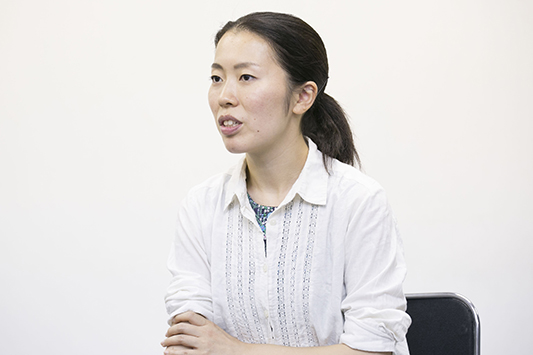
-Please tell us how you felt when rehearsals began.
Shirakami : (The choreographer and the person being choreographed) are both me. It's like a mirror. I talk with Sakai every time. It's like I'm reexamining myself, taking in what I'm good at and the choices I always make, and then I have the time to output them.
The choreographer pours out all of his/her ideas that are in line with his/her personal tastes. When I create my own dance, I worry about the amount of content, but I ask the dancers to not worry about that and just give it their all.
Sakai : When I heard about the role, I thought, "I'll choreograph for Shiragami-san, who is not at all cozy!" (laughs). At first, I was only thinking about drawing him to my strengths. But as I tried out various things while watching Shiragami-san's body in the actual rehearsal room, I thought it might be okay to do something like a choreography/tone of the piece that can only be achieved by having Shiragami-san dance.
It seems like we will be able to show a different side of choreographer Sakai, who will say, "I can do this kind of choreography too!" As a dancer, I hope Shiragami-san can bring out a new side of me.
-What do you mean when you say you're "going to be able to show a new side of yourself as a choreographer"?
Sakai : Shirakami-san has an exquisite sense of timing, so if you give her even the slightest bit of space, it becomes "Shirakami-style". I want to be careful about how I direct her while trying not to give her that space. Usually, it's more fun to style something that suits the person, but this time, if I did that, she would be pulled along by the dancer's strong personality and presence.
In the end, if it turns out to be the usual Shirakami, even if it was interesting, it would be a little frustrating for me as a choreographer. My goal is to create a piece that makes people think, "This is a Shirakami we've never seen before, and it's also an interesting piece."
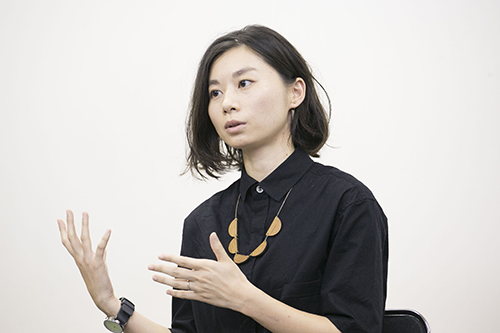
-How do you feel about it, Shirakami-san?
Shirakami : I hope I can show new sides of myself both as a choreographer and as a dancer. As we discuss and create the piece, we end up thinking, "I've never done this before..." We're taking on a new challenge. We've taken off most of Sakai-san's armor (laughs). I'm the type of person who will fall to hell, so I have to fall to the very bottom (laughs).
As for Sakai-san, I want to portray her as "not realizing that she's already fallen into hell." She's a smart person, so she can sense the state of hell and do something about it, so she thinks, "Maybe I'm pretty cool!", but in reality, she's at rock bottom (laughs).
Sakai : I think I'm cool because I'm quite a bit of a fool (laughs).
- The meaning behind the "stick" -
-Where does the title of the performance "Stick & uS!!" ~Us and the Stick~ come from?
Shirakami : I wanted it to have the momentum of Stick & uS!! (speaking fast and with a strong voice). Like a stick! (laughs). Like I want it to have spirit and energy. Like, that's good! (laughs).
Sakai : We decided it together and reported it to them after the fact (laughs).
-You actually use a stick, right?
Sakai : Yes. Also, as Mr. Ohira (Masahiro) of ST Spot Yokohama wrote on the flyer, the theme is "seeking motivation from the outside." Weave a story using something from the outside, not just something that comes from within yourself. Being choreographed is also an external stimulus. While I think that Shirakami and I have different characters, we have quite a few things in common, such as using a lot of props.
In the work Shirakami did at Yamate Goethe-Za (A Secret, Vaguely Remembered, March 2013), there was a scene where a dancer ran with a stick. I also have a work in which a dancer drags a stick (Pearl of the Deaf/Night in June, June 2010, Yokohama Creative City Center). We both used sticks (laughs). I think that (through the use of a stick) the differences in our interpretations as choreographers can be entertaining from the audience's point of view.
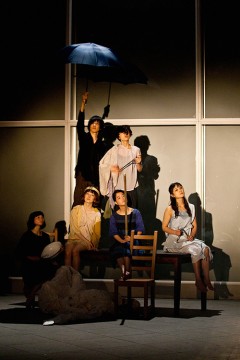 "Pearl of the Hearing Impaired" @YCC 2010 Photo: Kenki IIDA
"Pearl of the Hearing Impaired" @YCC 2010 Photo: Kenki IIDA
- Be aware of the space -
-This time, the performance is sponsored by ST Spot Yokohama Steep Slope Studio and co-sponsored by Yokohama City, and is part of a project called "SS Simple Stories." It is based on the premise of "minimal (simple) technical work and re-performance." In October, it will be performed at the middle studio of the affiliated KAAT Kanagawa Arts Theater, and is scheduled to be re-performed at ST Spot Yokohama in February next year.
Sakai : The scale of the venue is different.
Shiragami : It no longer fits into ST...
Sakai : I think we were both conscious of that when we were making it. We were kind of predicting that we would start with something big and then move on to something smaller.
- Although you both have different styles, I have the impression that you are always conscious of "space" when you create. I think you create with a clear image in mind.
Sakai : I can't create something unless I have a concrete image of the space.
Shirakami : I have an image, or rather I have an idea of "It would be like this there," "I want it to go here," or "This song would suit it."
Sakai : That's right. The way music resonates changes depending on the size of the space, and sometimes a certain song sounds dull in a certain size. It's all about balance.
It's okay to use this on KAAT, but not on ST. There are also cases where the opposite is true.
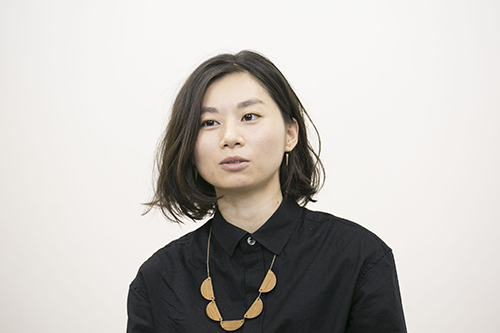
- The scariest place is the theater -
- Kanagawa has many wonderful art museums and other art spots. You do a lot of work in those spaces too. I don't know if this work can be performed outside of theaters and halls, but is there a big difference between dancing and creating in a theater and not?
Sakai : The sense of distance is different. On stage, it depends on how you use it, but it's basically face-to-face. At events, you might suddenly find yourself dancing in a crowd or in a situation where you have eyes on your back. You feel people looking at you from all over. I have many opportunities to dance outside of the stage, so I'm good at it, or rather, it suits me quite well. However, when it comes to choreography, it's a different story.
Shirakami : As a director, I'm not particularly rebellious when it comes to spaces that aren't theaters, but I do get excited about them. I get excited about things like the walls being green, the pillars, the mosquitoes outside... But when it comes to actually dancing in a theater, I'm scared.
Sakai : There's no escape...
Shirakami : Theaters where you face each other are the scariest. Outside you can blend in. Conversely, I'm good at the scariest places.
- The KAAT studio is a large space, so whether you're choreographing a solo or being choreographed, you have to face that space. It may be a bit overwhelming.
Shiragami : It's quite a cornering situation.
Sakai : I'm not worried about the dance piece because I'm entrusting myself to Shirakami's direction. The choreographer is thinking about how to create something using only the body. It will be a simple and original creation that places importance on the clothes, lighting and music. It's not about the body! It's about how to create a fragrant space.
--A fresh and surprising work that gives insight into the personalities of these two people--
-Finally, please give us a message and aspirations for our customers.
Sakai : I hope people enjoy the differences between the two works.
Shirakami : I want people who don't know us to feel like, "Oh, I get to know their personalities now," or "I get to know what kind of person they are." I also hope people find it genuinely entertaining. We're grasping at straws, so please come!
Sakai : I hope to present a fresh surprise and surprise to those who have seen our works and dance before. I'm more conscious than usual so that those who are seeing it for the first time can also enjoy it. I'll do my best so that those who are attracted to the project will leave with an interesting impression!!
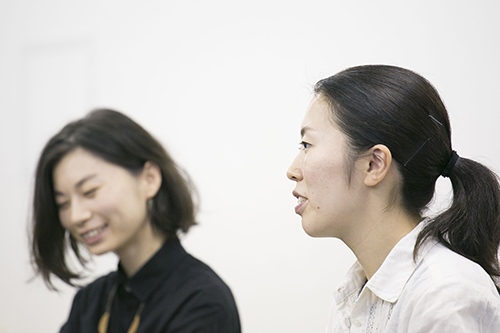
We went to some of the places they recommended! Editor's Note
After the interview, Magcal asked the two about their favorite places in Kanagawa Prefecture and recommended shops. The first thing they both said was that they both had one thing in common: nature. Sakai loves Chigasaki, and Shirakami loves Miura Beach. Sakai is originally from Chigasaki, and recommended Chigasaki, which has a lot of nature, including Satoyama Park.
Satoyama Park was created to protect the Satoyama landscape, where nature and human life coexist in harmony, with the ravine rice fields surrounded by mixed forests. Many people visit the park to enjoy the natural scenery. Just taking a walk while enjoying nature is a great way to refresh yourself.
Personally, I was interested in the 70m "Wind Slide," but it was so popular with kids that the good adult Magcal staff refrained from going...

The park was full of nature and it felt really good.
Shirakami-san recommended Kappo Ryokan Tachibana, a tuna specialty restaurant located right next to Misaki Port Station, which he stopped by when he went to see the ocean at Miura Beach.
Shirakami's recommendation is "Kama no Tatsutaage (840 yen including tax)". The rich taste of the fatty kama meat spreads the moment you put it in your mouth, and it is a wonderful dish with a moderate seasoning without any unpleasant odor! And, at the president's kindness, we also had the "Skin-on Fried Chicken (577 yen including tax)". Although it is called tuna skin, it seems to be the skin of the internal organs rather than the outside, and it has a chewy texture that is no longer skin but meat! It was a dish I had never eaten before! The staff at the restaurant were all very friendly.
If you visit Misaki Port, be sure to stop by.

From the left: "Kama no Tatsuta-age" and "Karaage with skin"
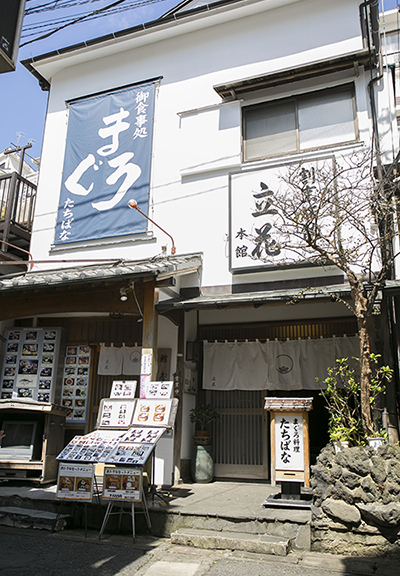
The building is five stories tall!
□ Tuna specialty restaurant "Kappo Ryokan Tachibana"
http://www7.ocn.ne.jp/~tacibana/
5-1-16 Misaki, Miura City, Kanagawa Prefecture, 238-0243
TEL: 046-881-2158
FAX: 046-881-2159
